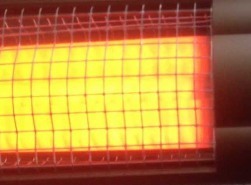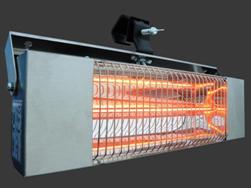Categories: Featured Articles » Interesting Facts
Number of views: 21477
Comments on the article: 1
Interesting facts about infrared heating
 Maybe many people noticed that in winter, at temperatures below minus 10, thawed patches appear on bright asphalt, and the water sparkles in the sun. So the temperature of the surface of the road or sidewalk does not match the temperature of the air?
Maybe many people noticed that in winter, at temperatures below minus 10, thawed patches appear on bright asphalt, and the water sparkles in the sun. So the temperature of the surface of the road or sidewalk does not match the temperature of the air?
A bit of physics: the solar radiation spectrum covers the range from the ultraviolet region to infrared, thermal radiation. In fact, this spectrum is much wider, but our atmosphere and the magnetic “screen” of the Earth regularly protect the planet and its inhabitants from the fierce flow of energy from the Sun.
And now we will return to the phenomenon at the beginning of the article, we will figure out what practical application it can find. All the heat that we receive from the Sun is transmitted by radiation, i.e. radiation. Each object (surface) perceives this radiation in a different way. Light materials and objects absorb heat rays weakly. Remember the summer: in what clothes - white or dark, were you comfortable? But dark, especially black objects, absorb infrared rays better and at the same time heat up.
With the answer "Why?" it seems clear: white snow reflects heat from the Sun, and dark asphalt absorbs and heats this heat, and to such a temperature that frost does not interfere with melting snow.
 More effective absorption of thermal rays by dark surfaces has found practical application in heating rooms using household infrared heaters. Now they use different methods of heating rooms: radiators, electric oil heaters, heat generators, close relatives of hair dryers. All of them use the principle of convection heating of air.
More effective absorption of thermal rays by dark surfaces has found practical application in heating rooms using household infrared heaters. Now they use different methods of heating rooms: radiators, electric oil heaters, heat generators, close relatives of hair dryers. All of them use the principle of convection heating of air.
Cool air flows around or blows around a hot surface, takes heat and, observing the laws of physics, rises up to the ceiling. But then we live on the surface of the floor! Why do we need comfortable conditions where we are not?
To combat a similar, "inconvenient" manifestation of physical laws, another type of heating device was developed. In appearance, there are no significant differences from previously known devices: the same spirals or heating elements (tubular electric heaters), a reflector, a power cord.
In fact, the difference is huge: these devices do not heat the air, but the surface of the floors, furniture, and finally your skin. And only then does the floor surface give off heat to the surrounding air. A comfortable temperature is created first at the bottom, and only then the heated air goes up.
But why are the thermal rays of an infrared heater not immediately absorbed by air? It is in this that the “highlight” of these devices lies. The fact is that in the infrared there are "windows" where thermal rays are weakly absorbed. The widest of these "windows" is located in the range from 8 to 13.5 microns (1 micrometer is equal to a millionth of a meter).
For thermal radiation, which has a wavelength close to it, the air is almost transparent (transmission 80-85%) and the rays freely reach the surface. Therefore, the temperature of the heating (radiating) elements is chosen very carefully. Usually for infrared heating electric heaters with a surface temperature of 400 - 600 degrees Celsius are used.
There are still a few questions: how effective are infrared heaters for saving energy and how to fit them into the modern interior of apartments or office premises?
The optimal placement of infrared heaters is the ceiling or top of the walls, closer to the ceiling. With this arrangement, the irradiation area is maximum. In rooms where there are false ceilings, you can mount heaters in a rectangular case, as well as fluorescent lamps.In other cases, they choose linear type heating devices that are mounted on the wall under the ceiling and less damage the interior of the room.
Finally, about the economics of using heaters using the principle of infrared heating. Most likely, many paid attention to the fact that in weather forecasts two temperature values are given: according to the thermometer and “it feels like”.
With an infrared heater, the temperature “feels like” can be noticeable, 5-7 degrees higher than that measured by the thermometer. A comfortable room temperature is maintained with a lower heater power, and this saves energy and money in your family budget. Exact calculations require taking into account the characteristics of the room, but 40-60% savings can be calculated.
See also at bgv.electricianexp.com
:
